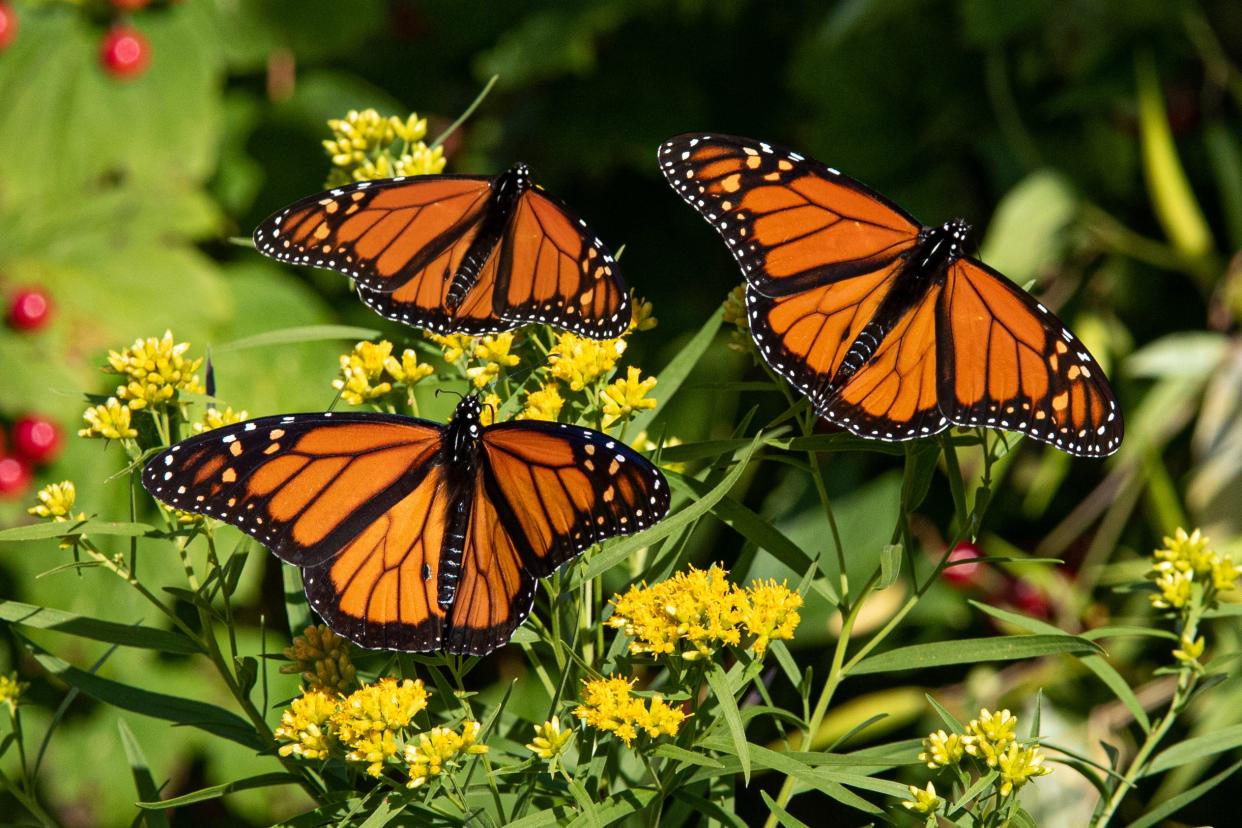Answer Woman: Has something disrupted the Monarch butterfly migration in WNC?

ASHEVILLE - Today's burning question is about the migratory patterns of monarch butterflies and if area residents are seeing fewer signs of their journey through Western North Carolina. Got a question for Answer Man or Answer Woman? Email Executive Editor Karen Chávez at KChavez@citizentimes.com and your question could appear in an upcoming column.
Question: My wife and I typically start seeing the monarch butterfly migration in mid-August. So far this year we have not seen one monarch. Has something disrupted their normal flight through WNC?
Answer: It's never just one thing. That was the observation of Erin Canter, the manager of science literacy and research at Great Smoky Mountains Institute at Tremont, a nonprofit organization specializing in experiential outdoor education.
There's any number of intersecting factors that may be impacting the population of the iconic monarch butterfly —or your chance of spotting them. The monarch is known for its striking coloration and its unique migratory patterns, which take the Eastern monarchs as far as 3,000 miles during their migration, traveling from the northern United States and Canada to their wintering grounds in Mexico.
Every fall, Western North Carolina and surrounding areas, including the Great Smoky Mountains National Park, play host to thousands of monarch butterflies on their journey, as they descend to nectar and take shelter in fields of native wildflowers and grasses.
Anecdotally, Canter said, the institute has noticed fewer butterflies in recent years, likely part of a global trend, pointing to a several factors that may play a part in dwindling numbers.
Among those, she said, is climate change, but also changing land use, the destruction of native milkweed — the monarch's sole host plant, on which its caterpillars feed exclusively — as well as herbicides, pesticides and habitat loss from development and ill-timed mowing.
In August, Canter said, monarchs are only trickling through the area. From mid-September through the end of October is when people should be on the lookout for the monarchs traveling en masse, with numbers peaking in mid-October.
Despite feeling like there are "fewer and fewer butterflies," Canter encouraged the reader not to lose hope, and said they can still expect to see monarch butterflies in the coming weeks. Throughout late summer and early autumn, volunteers participating in the GSMIT's butterfly education and monarch tagging program will assemble in Cades Cove, a verdant valley in the Great Smokies, seeking out the monarchs, but she said the butterflies can be found anywhere with open fields and late summer blooms.
She's spotted them at cafés in West Asheville or hovering outside the co-op — "nature is everywhere," Canter noted.
"Find a flower and stare at it for 10 minutes,” she recommended, laughing. In that small study alone, she said an observer will notice how many different kinds of life revolve around any single point.
Are monarch butterflies endangered?
While eastern monarchs are not federally listed as threatened or endangered, conservation groups point to worrying declines of some overwintering populations. In July 2022, the International Union for Conservation of Nature added the migrating monarch butterfly for the first time to its “red list” of threatened species and categorized it as "endangered" – two steps from extinct. according to reporting from USA TODAY.
The group estimates that the population of monarch butterflies in North America has declined 22% to 72% over 10 years, depending on the measurement method.
Being on the IUCN list is different than being listed as endangered under the Endangered Species Act, despite meeting the criteria, but Canter said monarchs are up for consideration.
While the species itself is not endangered, “what is actually endangered is the migration itself, which I think of as the culture of butterflies," Canter said.
How can you support monarchs?
To support monarchs, and their long journeys, Canter said people can plant native species of milkweed, and "let your yard not be a yard" by planting a native ecosystem, conserving it for insects and other species. Encourage others to do the same, she said, and "learn and notice" the creatures around you.
“When we notice species," she said, "we love them a little bit more."
NC Arboretum celebrates Monarch Butterfly Day
For the first time since 2019, on Sept. 30, the North Carolina Arboretum will celebrate Monarch Butterfly Day.
According to a Sept. 14 news release, attendees will be able to observe monarch butterflies in various life stages as well as connect with organizations devoted to preservation and support of monarch butterflies, while learning how they themselves can participate in conservation.
Inside the Baker Exhibit Center, people can get a first look at “Monarchs and Milkweed,” an immersive, multimedia experience running Sept. 30 through Jan. 7 that examines the relationship between these two species and how they have developed to depend on one another for survival.
Learn more at ncarboretum.org.
More: Answer Woman: When is daylight saving time in North Carolina? Will it be permanent?
More about monarchs: Word from the Smokies: Volunteers track monarch butterflies in national park
Sarah Honosky is the city government reporter for the Asheville Citizen Times, part of the USA TODAY Network. News Tips? Email shonosky@citizentimes.com or message on Twitter at @slhonosky. Please support local, daily journalism with a subscription to the Citizen Times.
This article originally appeared on Asheville Citizen Times: Answer Woman: When should you watch for migrating monarchs in WNC?

